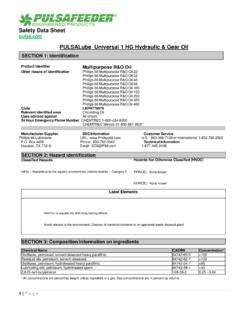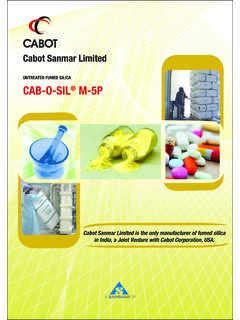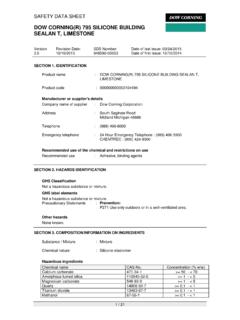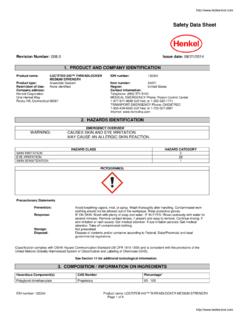Transcription of Material Safety Data Sheet PeriFlo Silicone Grease
1 Last Reviewed: Apr 2013. Next Review Due: Apr 2016. MSDS-P-011. Material Safety data Sheet PeriFlo Silicone Grease 1. Product and Company Identification Product Name: Tribolube-110909C Lubricating Grease Identified Uses: Lubricating Grease Uses advised against: None known. Company: Aerospace Lubricants, Inc. 1600 Georgesville Rd. Columbus, OH 43228. USA. Customer Service: Tel: (614) 878-3600. General E-mail: SDS Prepared by: Joseph Heer, SDS E-mail: Emergency Phone Number: Tel: (614) 878-3600. 2. Hazards Identification Classification of the substance or mixture Non-hazardous. according to EU Directives 67/548/EEC or 1999/45/EC: Required Labeling Elements: GHS Label Elements, per (EC) No 1272/2008 No special labeling required.
2 OSHA/HCS Elements, per OSHA 29 CFR : No special labeling required. Risk Phrases: None. Safety Phrases: S51 Only use in well-ventilated areas. Other Hazards: Combustible. Not a PBT, vPvB substance as per the criteria of the REACH Ordinance. 3. Composition / Information on Ingredients Substance/Mixture: Mixture Chemical characterization: PFPE-based Lubricant EC Concentration Chemical Name CAS number Classification Number %. 67/548/ EEC (EC)1272/2008. Polydimethylsiloxane 63148-62-9 polymer 80-90%. Not classified. Not classified. Polydimethylsiloxane, hydroxy- 70131-67-8 polymer Not classified. Not classified. < 10%. terminated 112945-52-5 was: Amorphous fumed silica 231-545-4 Not classified. Not classified. <= 5%. 7631-86-9.
3 See section 15 for the full text of the R- & H-phrases declared above. There are no additional ingredients present which are classified as hazardous to health or the environment and require reporting in this section. CLP. classifications are based on all current available data including from known international organizations. These classifications are subject to revision as more information becomes available 4. First Aid Measures Description of Necessary First Aid Measures: General Advice: Get medical attention if symptoms occur. Contaminated clothing to be placed in closed container until disposal or decontamination. Eye Contact: Check for and remove any contact lenses. Immediately flush eyes, including under eyelids, with plenty of water for at least 15 minutes.
4 Get medical attention if irritation persists. Skin Contact: Remove contaminated clothing and shoes. Wash with soap and water as a precaution. Get medical attention if irritation persists. Inhalation: Move to fresh air in case of accidental inhalation of fumes from overheating or combustion. Ingestion: Do not induce vomiting. Rinse mouth thoroughly and drink plenty of water afterwards. Get medical attention if symptoms appear. Most important symptoms and effects, both acute and delayed Symptoms: None known. Vapors from heated Material may cause eye irritation, discomfort, blurred vision, cough & sneezing, headache, hoarseness, throat pain. Indication of any immediate medical attention and special treatment needed Specific treatments: Not applicable.
5 Notes to physician: No special concerns. Treat symptomatically. Protection of first responders: No unusual fire or explosion hazards are expected. Make sure any action taken is done by personnel with suitable training 5. Fire-Fighting Measures Suitable extinguishing media: Extinguish with foam, carbon dioxide or dry powder. Unsuitable extinguishing media: Do not use water jet as an extinguisher, because this will spread the fire. Hazards during firefighting: In fire conditions, toxic decomposition products may be formed. Hazardous Combustion Products: Carbon oxides, amorphous silica . Flammability of the Product: Combustible. Special precautions for fire-fighters: Water spray should be used to cool containers. Special protective equipment for fire-fighters: No unusual fire or explosion hazards are expected.
6 Fire fighters should wear appropriate protective equipment and self-contained respirator (SCBA) for surrounding conditions. Further Information: This Material is not explosive as defined by established regulatory criteria. However, if a closed container of the lubricant is exposed to a fire or excessive heat, a pressure increase will occur and the container may burst. Cool containers with water or water spray. 6. Accidental Release Measures Personal Precautions protective equipment and emergency procedures: Wear appropriate personal protection equipment (See Section 8.) Use local ventilation if necessary Environmental Precautions: Prevent Material from entering sewers, waterways, or low areas. Avoid other environmental releases.
7 Collect spilled Material . Methods for Containment and Clean-Up: Containers with collected spillage must be properly labeled with correct contents and hazard symbol. Container must be kept tightly closed. Absorb with sand or other inert absorbent. To clean the floor and all objects contaminated by this Material , use an appropriate solvent. Flush area with plenty of water. Incinerate in suitable combustion chamber 7. Handling and Storage Precautions for Safe Handling: Take precautionary measures against static discharge. Use normal good hygiene practices. Conditions for Safe Storage Including Incompatibilities: Requirements for storage areas & containers: Avoid discharge into drains, water courses or onto the ground. Store in a cool, dry place with adequate ventilation.
8 Keep away from incompatible materials, open flames, and high temperatures. Avoid contact with oxidizing agents. Suitable containers: Steel drums coated with epoxy-resin. Other data : Storage temperature: Minimum 0 C, Maximum 40 C. Stable under recommended conditions. No decomposition will occur if stored and applied as directed. Specific Uses: Lubricating Grease . Refer to technical data Sheet available on request. 8. Exposure Controls / Personal Protection Control parameters: Occupational exposure limit values: Amorphous fumed silica (CAS 112945-52 2) has TWA limits of: 6 mg/m3 inhalable dust; mg/m3 respirable dust. Environmental exposure controls: Engineering Controls: In the event that the Material is heated above 300 C (572 F) local ventilation should be used to avoid exposure to fumes.
9 Personal protection measures: Hygiene measures: When using, do not eat, drink or smoke. Wash face and/or hands before break and end of work. Wash contaminated clothing before reuse. Hand protection: Protective gloves made of Nitrile or Polyvinyl chloride (PVC). Use insulating gloves when handling hot Material . Eye/face protection: Safety glasses with side shields. Skin & body protection: Minimize skin contact. Wear suitable protective clothing. Wash contaminated clothing before reuse. Respiratory protection: This product cannot normally be inhaled, and personal respiratory protective equipment is not normally required. In the case of hazardous fumes caused by overheating, wear self-contained breathing apparatus. Additional information: These precautions are for room temperature handling.
10 Use at elevated temperatures or in aerosol / spray applications require added precautions. 9. Physical and Chemical Properties Information on basic physical and chemical properties Physical State: Grease Color: White Odor: None pH: Not applicable Melting Point (Dropping Point): > 304 C. Flash Point: > 280 C. Thermal Decomposition: > 200 C. Vapor Pressure: <= hPa @ 20 C. Relative Density: - at 25 C. Water Solubility: Insoluble. Base Oil Solubility: Miscible with aliphatic & aromatic hydrocarbons, diethylether, chlorinated solvents. Very slightly soluble in acetone & ethanol. Oxidizing properties: Not considered as oxidizing. Other Information No data available The above information is not intended for use in preparing product specifications.








